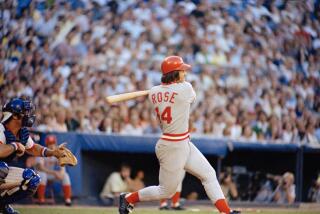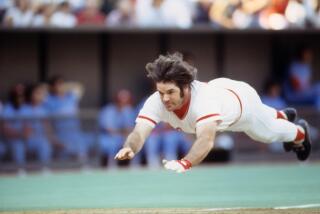‘The Squire’ Is Dead at 97
- Share via
Gene Sarazen, one of the seminal figures in golf who died Thursday in Naples, Fla., made what is probably the most famous shot the game has ever seen, but he didn’t want to discuss it.
“Aw, that’s boring, that’s old stuff,” said Sarazen, a few months before his death.
You mean you really don’t want to talk about your double eagle on the 15th hole that helped you win the 1935 Masters?
“Nope,” he said.
So what do you want to talk about?
“You know, my father studied for the priesthood,” Sarazen answered quickly. “He was a carpenter in Connecticut. I was supposed to be one too. But I got pleurisy and the doctors told me to find less strenuous work. While I was recuperating, I took up golf.
“I guess it’s funny the way things turn out, isn’t it?”
Well, yes, it is, especially for Eugenio Saraceni, the son of an Italian immigrant, who changed his last name because it sounded too much like the name of a violinist and turned out to be one of the most influential, historic and talented golfers ever to swing a club.
Known as the Squire for his courtly demeanor and his style, Sarazen won the PGA Championship three times, the U.S. Open twice, the Masters once and the British Open once.
He was one of only four players to win all four majors--Ben Hogan, Jack Nicklaus and Gary Player were the others.
Sarazen was 97 when he died early Thursday morning at Naples Community Hospital from complications of pneumonia. Sarazen, who lived at Marco Island, Fla., had been hospitalized for several days. His last public appearance was last month on the first day of the Masters, where he hit a ceremonial first ball, along with 87-year-old Byron Nelson and 86-year-old Sam Snead.
Nelson said Sarazen’s death represents an important date on golf’s time line.
“You got [Walter] Hagen, [Francis] Ouimet, Sarazen and [Bobby] Jones,” Nelson said. “So that’s the end of that era. And that’s a nostalgic sort of thing to feel. He almost made it for one whole century.”
Snead said he spoke briefly with Sarazen on the first tee at Augusta National five weeks ago and asked Sarazen if he still walked on the beach.
“He said ‘Hell, no. Had to give it up,’ ” Snead said. “Feisty as usual, I guess. You know, he kept himself going all the time. His mind was still good. Goodness, the way I’m going, I’m going to have to have somebody steer me.”
Nobody really had to steer Sarazen once he took up golf. He was a natural. At least that’s what others thought, although Sarazen needed to work diligently at the game to make himself appear that way.
He won his first major title at the 1922 U.S. Open at Skokie Country Club in Glencoe, Ill., when he was 20. His final round of 68 made Jones a runner-up by one shot. Sarazen also won the PGA in 1922 and won it again in 1923 when he beat Hagen in the finals.
Only 21, Sarazen already owned three major titles.
In 1932, Sarazen won the U.S. Open and the British Open in brilliant fashion. His final-round 66 in the U.S. Open at Fresh Meadows Country Club in Flushing, N.Y., was called “the finest competitive round ever played” by Jones. Sarazen’s total of 283 at Prince’s was a British Open record and beat Macdonald Smith by five shots.
It was at that British Open 67 years ago where Sarazen made history. He played with his new invention--the sand wedge.
“Gene just took a nine-iron with a big sole and right away, the clubmakers figured that this club was great,” Nelson said.
Sarazen revealed years later that he actually came up with the sand wedge in 1931, but kept it hidden until the 1932 British Open because he was afraid it would be banned as illegal. Instead, it was one of the greatest advancements in golf club technology.
Paul Runyan, 90, the two-time PGA champion, called the sand wedge “the most dramatic development in my 79 years around the game of golf.”
Aside from creating the sand wedge, consider what Sarazen did to the Masters. It was only a year-old tournament, Jones’ fledgling get-together with his friends called the Augusta National Invitational at a new course when Sarazen put it on the map in 1935.
Sarazen trailed Craig Wood by three shots on the last day, but stood over his second shot on the par-five 15th hole. With 235 yards to the pin, Sarazen swung his four-wood and sent the ball toward the green, hoping to clear the water in front. That’s what happened, but Sarazen got much more than he bargained for.
The ball landed on the far bank of the water hazard, rolled onto the green and then continued straight into the hole.
He had made two on a par five--a double eagle.
There were only a dozen or so spectators around the green, but one of them was Jones. Sixty years later, Sarazen still wished he had been able to see the ball disappear into the hole.
“I couldn’t see that far,” Sarazen once said. “All I could see was the people jumping up and down. It was a lucky shot. I was playing for position, you know. I usually didn’t hit [a four-wood] that far, but I had to be pumped up. When you hole a shot like that, it’s luck. It’s not something you expect to get. There’s a lot of luck in golf.”
Luck, fate, whatever, the double eagle was a pivotal moment. It validated the Masters, defined Sarazen’s career and made golf history.
Wood, who was already in the clubhouse, had Sarazen down by three shots and now Sarazen had caught him on one hole. In a 36-hole playoff on Monday, Sarazen beat Woods by five shots. If you counted his four practice rounds, Sarazen played 180 holes at Augusta National that week.
He made $1,500.
Runyan said Sarazen’s double eagle was “somewhat of an accident.” Not that it mattered, though.
“But let’s don’t talk about his game,” said Runyan, who won the PGA Championship in 1934 and 1938. “It was dynamic enough. He was a true giant of golf. He was a truly great champion. He was interested in everything, and his career is something to behold.”
Sarazen’s career endured. He won the 1954 PGA Seniors title at 52 and at 71 made a hole in one at the famed Postage Stamp hole at Royal Troon in the 1973 British Open. He never played another tournament.
Regarded as outspoken in an era when most players rarely revealed much outside the ropes, Sarazen was regularly quoted in his later years on such subjects as the emphasis on power, courses that were too big, slow play by such greats as Hogan and Nicklaus and also the use of golf carts that costs poor kids jobs as caddies.
“Gene was always very vocal,” Nelson said. “He got a lot of publicity because he would always talk about things, one way or the other. But he always had an opinion.”
Sarazen said he made $700 for his U.S. Open victory in 1922 and $500 for the British Open in 1932. He didn’t begrudge the current professional players for playing for so much more money.
“Hey, they’re good fellows, they’re gentlemen and they deserve it,” Sarazen said. “I wouldn’t trade my time for theirs anyway. I’ve got a lot of good memories.”
Snead said his memory of Sarazen is one of a terrific competitor who would battle until the end. He said there’s nothing that could diminish that image.
“I tell you, he was as tenacious as anyone who ever came down the pike,” Snead said. “I tell you, he was about as good as anyone could be. I admired him so much.
“I think other people feel the same as me. They’ll say, ‘Gee, he was something, wasn’t he?’ ”
(BEGIN TEXT OF INFOBOX / INFOGRAPHIC)
Gene Sarazen Highlights
* Seven major championships--U.S. Open (1922, 1932); PGA Championship (1922, 1923, 1933); British Open (1932); and Masters (1935).
* The first of only four players to win all four Grand Slam titles (others are Ben Hogan, Jack Nicklaus and Gary Player).
* Member of six Ryder Cup teams.
* Charter member World Golf Hall of Fame.
* Invented sand wedge in 1931.
MOST PGA WINS
1. Sam Snead: 81
2. Jack Nicklaus: 70
3. Ben Hogan: 63
4. Arnold Palmer: 60
5. Byron Nelson: 52
6. Billy Casper: 51
7. Walter Hagen: 40
7. Cary Middlecoff: 40
9. Gene Sarazen: 38
10. Lloyd Mangrum: 36
MOST MAJORS
1. Jack Nicklaus: 18
2. Walter Hagen: 11
3. Gary Player: 9
4. Ben Hogan: 8
4. Tom Watson: 8
6. Arnold Palmer: 7
6. Sam Snead: 7
6. Gene Sarazen: 7
6. Bobby Jones: 7
6. Harry Vardon: 7
More to Read
Go beyond the scoreboard
Get the latest on L.A.'s teams in the daily Sports Report newsletter.
You may occasionally receive promotional content from the Los Angeles Times.










